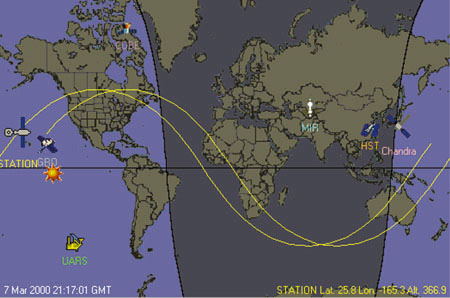Identified Flying Objects
By Michael Szpir
A NASA Web site maps orbiting spacecraft
A NASA Web site maps orbiting spacecraft

DOI: 10.1511/2000.23.0
The evening sky is filled with little points of light that move . . . some of them strangely so. Too slow to be meteors, too high to be jet planes, these tiny travelers are often noticed from the corner of one's eye by their steady passage across the sky. Seasoned skygazers will know that they are probably spacecraft, but few will know which ones they are. Now, however, anyone with access to the Internet can find out. Check out the LiftOff Web site, where NASA's Marshall Space Flight Center has recently established a couple of online applets to help skygazers track these lights.

NASA Marshall Space Flight Center
The J-Track applet shows the current positions of key spacecraft—including the Space Station, the Space Shuttle, the Mir Space Station and the Hubble Space Telescope—with little cartoon drawings that move in "real time" across a map of the world (right). Viewers can click on the cartoon spacecraft to observe its ground trace, orbital data and many other details.
Another applet, J-Pass, plots the overhead crossing times for all manner of satellites—including those for weather, communications, navigation and science missions—from any location on earth. J-Pass provides a graphic display of the times when various satellites are visible above your home, as well as their paths across the sky.
Some moving lights will have to remain unidentified, however: The applets refuse to plot the overhead passage of military and air-defense satellites. —Michael Szpir
Click "American Scientist" to access home page
American Scientist Comments and Discussion
To discuss our articles or comment on them, please share them and tag American Scientist on social media platforms. Here are links to our profiles on Twitter, Facebook, and LinkedIn.
If we re-share your post, we will moderate comments/discussion following our comments policy.